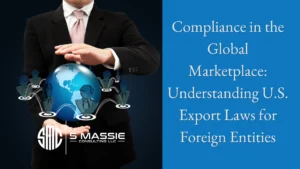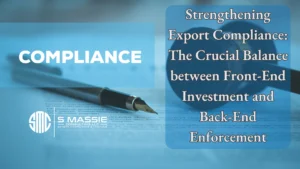The Cost of Non-Compliance
Did you know that the cost for non-compliance can be much more than the cost associated with being compliant? As former U.S. Deputy Attorney General Paul McNulty put it, “If you think compliance is expensive, try non-compliance.”
The Financial Consequences
Non-compliance with regulations can result in significant financial consequences for businesses. Fines, penalties, and legal expenses can quickly add up, surpassing the costs of establishing and maintaining compliance measures. Organizations must recognize that investing in compliance is essential to avoid the heavy financial burden that comes with non-compliance.
For instance, let’s consider the case of Kleiss & Co. BV, a company from the Netherlands. They ordered an EAR99 classified sealant from a U.S. supplier with a value of $20,951. Despite the order being flagged and stopped by a smart U.S. freight forwarder, Kleiss & Co. willfully violated U.S. regulations by shipping the order to Iran in June 2016. They repeated the same violation in March 2017, but the order was intercepted by the Bureau of Industry and Security (BIS) at the border.

As a consequence, Kleiss & Co. reached a settlement with the BIS in which they were required to pay a total of $55,000. Furthermore, they were debarred from participating in U.S. export transactions for two years, with the suspension of the debarment conditional upon timely payment. This fine exceeded the total value of their orders and far surpassed any potential profit they would have made.
The Importance of Compliance Programs
It’s crucial for companies, both domestic and foreign, to have comprehensive compliance programs in place to ensure adherence to U.S. regulations. Even if a product is classified as EAR99, which signifies a low level of export control, there are still regulations and requirements that must be followed. Failing to establish and maintain an Export Compliance Program can lead to severe penalties and reputational damage.
An effective compliance program includes written policies, procedures, and controls tailored to the specific industry and organization. Regular internal audits and assessments should be conducted to identify and address compliance gaps. Employee training and awareness programs are vital to educate staff on their roles and responsibilities regarding compliance.
Furthermore, compliance programs should encompass export control measures, data protection protocols, anti-money laundering procedures, environmental regulations, and workplace safety guidelines, among others. Each industry has its own set of compliance requirements, and organizations must stay updated on the evolving regulatory landscape to ensure full compliance.
The Risks of Non-Compliance
Apart from the immediate financial consequences, non-compliance poses several risks for businesses. These risks can have long-lasting effects on a company’s reputation, operations, and relationships with stakeholders.
Reputational Damage
Non-compliance incidents can significantly damage a company’s reputation. News of violations can spread quickly, thanks to social media and online platforms, leading to public scrutiny and negative publicity. Consumers and stakeholders may view the non-compliant organization as unethical, unreliable, or untrustworthy, resulting in a loss of customer trust and loyalty. Rebuilding a damaged reputation takes time, effort, and resources.
Legal Ramifications
Non-compliance often leads to legal disputes and litigation. Violations of regulations can result in lawsuits, regulatory investigations, and enforcement actions. Legal battles can be lengthy, expensive, and disruptive to a company’s operations. In addition to legal expenses, organizations may face fines, penalties, and even criminal charges, depending on the nature and severity of the non-compliance.
Operational Disruptions
Non-compliance can disrupt an organization’s day-to-day operations. Remediation efforts, such as implementing new processes, systems, or documentation, can be time-consuming and resource-intensive. Non-compliance incidents may require additional reporting, monitoring, and oversight, diverting valuable time and resources away from core business activities. Operational disruptions can affect productivity, efficiency, and overall business performance.
Loss of Business Opportunities
Non-compliance can lead to the loss of business opportunities. Customers, suppliers, and partners may hesitate to engage with non-compliant organizations due to concerns about legal and reputational risks. Government contracts, licensing agreements, and partnership opportunities may be withheld or revoked. Non-compliance can limit market access, hinder growth, and negatively impact revenue and profitability.
Proactive Compliance Measures
To mitigate the risks and costs of non-compliance, organizations should adopt proactive compliance measures. This involves establishing a culture of compliance, investing in robust compliance programs, and continuously monitoring and adapting to regulatory changes. Here are some key steps to consider:
Compliance Risk Assessment
Conduct a comprehensive compliance risk assessment to identify potential areas of non-compliance within the organization. Evaluate existing processes, systems, and practices to pinpoint vulnerabilities and gaps. This assessment forms the basis for developing targeted compliance strategies.
Written Policies and Procedures
Develop and implement written policies and procedures that clearly outline compliance expectations and guidelines. These documents should be accessible to all employees and regularly updated to reflect changes in regulations or internal processes. Policies should cover various compliance aspects, including data protection, financial reporting, export controls, anti-corruption, and more.
Training and Education
Provide regular training and education programs to employees at all levels of the organization. Training should cover relevant laws, regulations, and industry best practices. It should also emphasize the importance of ethical conduct, reporting mechanisms, and the consequences of non-compliance. Ongoing training ensures that employees remain aware of their compliance responsibilities and promotes a culture of compliance.
Compliance Monitoring and Auditing
Implement a robust compliance monitoring and auditing program to proactively identify and address non-compliance issues. Regular audits should be conducted to assess compliance with internal policies and external regulations. The results of audits should be used to identify areas for improvement and implement corrective actions.
Reporting and Whistleblower Protection
Establish clear reporting mechanisms for employees to report suspected compliance violations or concerns. Whistleblower protection policies should be in place to protect individuals who report non-compliance from retaliation. Encouraging an open and transparent reporting culture can help identify and address compliance issues before they escalate.
Continuous Compliance Improvement
Compliance is an ongoing effort that requires continuous improvement. Stay informed about changes in regulations, industry standards, and best practices. Regularly review and update compliance policies and procedures to align with evolving requirements. Engage with legal and compliance professionals to ensure compliance efforts are up to date and effective.
Seeking Expert Assistance
Navigating the complex landscape of compliance can be challenging for organizations. It is often beneficial to seek expert assistance to ensure comprehensive compliance measures are in place. Consultants, such as S Massie Consulting LLC, can provide valuable guidance and support in developing and maintaining effective compliance programs tailored to an organization’s specific needs.
Expert consultants can assist in conducting compliance risk assessments, developing policies and procedures, training employees, and conducting compliance audits. Their expertise and industry knowledge can help organizations stay ahead of regulatory changes, mitigate risks, and protect their reputation and financial well-being.
Conclusion
In conclusion, non-compliance carries significant consequences beyond financial penalties, including reputational damage, legal ramifications, operational disruptions, and missed business opportunities. To mitigate these risks, organizations must prioritize compliance by investing in tailored compliance programs, conducting regular assessments, providing comprehensive training, implementing effective monitoring and reporting mechanisms, and seeking expert assistance when needed. By doing so, businesses can protect their reputation, ensure legal and regulatory compliance, and secure long-term success in an increasingly regulated business landscape.
Non-compliance can result in heavy fines, penalties, and legal expenses that surpass the costs of implementing and maintaining compliance measures.
Yes, both domestic and foreign companies are subject to compliance regulations and can face consequences for non-compliance.
Non-compliance can lead to reputational damage, legal ramifications, operational disruptions, and missed business opportunities, which can have long-term negative effects on a company.
Organizations can establish a culture of compliance by providing comprehensive training, developing clear policies and procedures, implementing reporting mechanisms, and fostering a safe and confidential environment for reporting compliance concerns.
Compliance programs should consider the industry, geographical locations of operation, and the nature of the business. Conducting compliance risk assessments and seeking expert assistance can help tailor programs to address specific risks and compliance requirements.
Regular audits and monitoring activities help organizations assess the effectiveness of compliance measures, identify non-compliance issues, and take corrective actions promptly.
Whistleblower protection policies encourage employees to report suspected compliance violations without fear of retaliation, ensuring early detection and prevention of major compliance breaches.
External consultants can provide expertise in interpreting complex regulations, conducting compliance gap analyses, and staying up-to-date with emerging compliance trends, helping organizations enhance their compliance programs and mitigate risks.
Reputational damage can lead to a loss of customer trust, decreased market share, strained relationships with stakeholders, and potential long-term negative impacts on the organization’s brand and business performance.
Organizations should stay informed about regulatory changes, engage with legal and compliance professionals, conduct regular compliance reviews, and update policies and procedures to align with evolving requirements.
Does your company have a written Export Compliance Program in place to make sure you are in compliance with U.S. regulations?
To avoid this type of situation, contact S Massie Consulting today for a free consultation!


